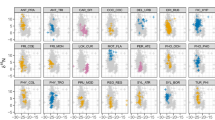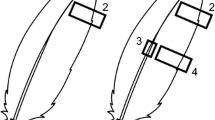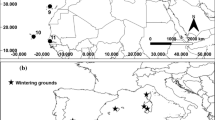Abstract
Deuterium isotope analyses have revolutionized the study of migratory connectivity because global gradients of deuterium in precipitation (δDP) are expressed on a continental scale. Several authors have constructed continental scale base maps of δDP to provide a spatial reference for studying the movement patterns of migratory species and, although they are very useful, these maps present a static, 40-year average view of the landscape that ignores much underlying inter-annual variation. To more fully understand the consequences of this underlying variation, we analyzed the GNIP deuterium data, the source for all current δDP maps, to estimate the minimum separation in δDP (and latitude) necessary to conclude with a given level of confidence that distinct δDP values represent different geographic sites. Extending analyses of δDP successfully to deuterium in tissues of living organisms, e.g., feathers in migratory birds (δDF), is dependent on the existence of geographic separation of δDP, where every geographic location has a distribution of values associated with temporal variability in δDP. Analyses were conducted for three distinct geographic regions: North America, eastern North America (east of longitude 100°W), and Argentina. At the 80% confidence level, the minimum separation values were 12, 7, and 14° of latitude (equivalent to 53, 31, and 32‰) for North America, eastern North America, and Argentina, respectively. Hence, in eastern North America, for example, one may not be able to accurately assign individual samples to sites separated by less than about 7° of latitude as the distributions of δDP were not distinct at latitudes <7° apart. Moreover, two samples that differ by less than 31‰ cannot be confidently said to originate from different latitudes. These estimates of minimum separation for δDP do not include other known sources of variation in feather deuterium (δDF) and hence are a first order approximation that may be useful, in the absence of more specific information for the system of interest, for planning and interpreting the results of new stable isotope studies.



Similar content being viewed by others
References
Bearhop S, Waldron S, Votier SC, Furness RW (2002) Factors that influence assimilation and fractionation of nitrogen and carbon stable isotopes in avian blood and feathers. Physiol Biochem Zool 75(5):451–458
Bowen GJ (2003) Global and regional maps of isotope ratios in precipitation. http://www.waterisotopes.org/. Cited 30 July 2007
Bowen GJ (2008) Spatial analysis of the intra-annual variation of precipitation isotope ratios and its climatological corollaries. J Geophys Res 113:D05113. doi:10.1029/2007JD009295
Bowen GJ, Revenaugh J (2003) Interpolating the isotopic composition of modern meteoric precipitation. Water Resour Res 39:1299. doi:10.129/2003WR002086
Bowen GJ, Wassenaar LI, Hobson KA (2005) Global application of stable hydrogen and oxygen isotopes to wildlife forensics. Oecologia 143:337–348
Cade BS, Noon BR (2003) A gentle introduction to quantile regression for ecologists. Front Ecol Environ 1:412–420
Dansgaard W (1964) Stable isotopes in precipitation. Tellus 16:436–469
He K (1997) Quantile curves without crossing. Am Stat 51:186–192
Hobson KA (1999) Tracing origins and migration of wildlife using stable isotopes: a review. Oecologia 120:314–326
Hobson KA (2005) Stable isotopes and the determination of avian migratory connectivity and seasonal interactions. Auk 122:1037–1048
Hobson KA, Clark RG (1992) Assessing avian diets using stable isotopes II: actors influencing diet-tissue fractionation. Condor 94:189–197
Hobson KA, Wassenaar LI (1997) Linking breeding and wintering grounds of neotropical migrant songbirds using stable hydrogen isotopic analysis of feathers. Oecologia 109:142–148
Hobson KA, McFarland KP, Wassenaar LI, Rimmer CC, Goetz JE (2001) Linking breeding and wintering grounds of Bicknell’s Thrushes using stable isotope analyses of feathers. Auk 118:16–23
Hobson KA, Wassenaar LI, Bayne E (2004a) Using isotopic variance to detect long-distance dispersal and philopatry in birds: an example with ovenbirds and American redstarts. Condor 106:732–743
Hobson KA, Bowen GJ, Wassenaar LI, Ferrand Y, Lormee H (2004b) Using stable hydrogen and oxygen isotope measurements of feathers to infer geographical origins of migrating European birds. Oecologia 141:477–488
IAEA/WMO (2001) Global Network of Isotopes in Precipitation. http://isohis.iaea.org. Cited 30 July 2007
Kelly JF, Finch DM (1998) Tracking migrant songbirds with stable isotopes. Trends Ecol Evol 13:48–49
Kelly JF, Atudorei V, Sharp ZD, Finch DM (2002) Insights into Wilson’s warbler migration from analyses of hydrogen stable-isotope ratios. Oecologia 130:216–221
Kelly JF, Johnson MJ, Langridge S, Whitfield M (2008) Efficacy of stable isotope ratios in assigning endangered migrants to breeding and wintering sites. Ecol Appl 18:568–576
Koenker R (2005) Quantile regression econometric society monographs. Cambridge University Press, New York
Langin KM, Reudink MW, Marra PP, Norris DR, Kyser TK, Ratcliffe LM (2007) Hydrogen isotopic variation in migratory bird tissues of known origin: implications for geographic assignment. Oecologia 152:449–457
Lajtha K, Michener RH (1994) Stable isotopes in ecology and environmental science. Blackwell, London
Lott CA, Smith JP (2006) A geographic-information-system approach to estimating the origin of migratory raptors in North America using stable hydrogen isotope ratios in feathers. Auk 123:822–835
Marra PP, Hobson KA, Holmes RT (1998) Linking winter and summer events in a migratory bird by using stable-carbon isotopes. Science 282:1884–1886
Mazerolle DF, Hobson KA (2005) Estimating origins of short distance migrant songbirds in North America: contrasting inferences from hydrogen isotope measurements of feathers, claws, and blood. Condor 107:280–288
Mazerolle DF, Hobson KA, Wassenaar LI (2005) Stable isotope and band encounter analyses delineate migratory patterns and catchment areas of white-throated sparrows at a migration monitoring station. Oecologia 144:541–549
McCarthy ID, Waldron S (2000) Identifying migratory Salmo trutta using carbon and nitrogen stable isotopes rations. Rapid Commun Mass Spectrom 14:1325–1331
Meehan TD, Lott CA, Sharp ZD, Smith RB, Rosenfield RN, Stewart AC, Murphy RK (2001) Using hydrogen isotope geochemistry to estimate the natal latitudes of immature Cooper’s Hawks migrating through the Florida keys. Condor 103:11–20
Meehan TD, Giermakowski JT, Cryan PM (2004) GIS-based model of stable hydrogen isotope ratios in North American growing-season precipitation for use in animal movement studies. Isotopes Environ Health Stud 40:291–300
Norris DR, Marra PP, Montgomerie R, Kyser TK, Ratcliffe LM (2004) Reproductive effort, molting latitude, and feather color in a migratory songbird. Science 306:2249–2250
Rubenstein DR, Hobson KA (2004) From birds to butterflies: animal movement patterns and stable isotopes. Trends Ecol Evol 19:256–263
Szymanski ML, Afton AD, Hobson KA (2007) Use of stable isotope methodology to determine natal origins of Mallards at a fine scale within the upper Midwest. J Wildl Manage 71:1317–1324
Villagra PE, Villalba R, Boninsegna JA (2005) Structure and growth rate of Prosopis flexuosa woodlands in two contrasting environments of the central Monte desert. J Arid Environ 60:187–199
Vogel JC, Eglington B, Auret JM (1990) Isotopes fingerprints in Elephant bone and ivory. Nature 346:744–747
Webster MS, Marra PP, Haig SM, Bensch S, Holmes RT (2002) Links between worlds: unraveling migratory connectivity. Trends Ecol Evol 17:76–83
Wunder MB, Kester CL, Knopf FL, Rye RO (2005) A test of geographic assignment using stable isotope tracers in feathers of known origin. Oecologia 144:607–617
Wunder MB, Norris DR (2008) Improved estimates of certainty in stable-isotope-based methods for tracking migratory animals. Ecol Appl 18:549–559
Xie R, Nelson PI (2003) Separation among distributions related by linear regression. Am Stat 57:33–36
Yohannes E, Hobson KA, Pearson DJ (2007) Feather stable-isotope profiles reveal stopover habitat selection and site fidelity in nine migratory species moving through sub-Saharan Africa. J Avian Biol 38:347–355
Acknowledgments
Paul Cryan, Katie Langin, Mike Wunder, and two anonymous referees reviewed earlier versions of the manuscript and provided helpful comments. Funding for our research was provided by the US Geological Survey, and The Fullbright Foundation. This work was conducted in compliance with laws of the United States of America.
Author information
Authors and Affiliations
Corresponding author
Additional information
Communicated by Carlos Martinez del Rio.
Rights and permissions
About this article
Cite this article
Farmer, A., Cade, B.S. & Torres-Dowdall, J. Fundamental limits to the accuracy of deuterium isotopes for identifying the spatial origin of migratory animals. Oecologia 158, 183–192 (2008). https://doi.org/10.1007/s00442-008-1143-6
Received:
Accepted:
Published:
Issue Date:
DOI: https://doi.org/10.1007/s00442-008-1143-6




